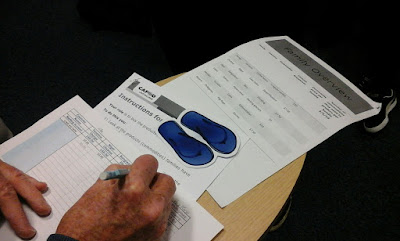This term we have started refreshing and reformatting our first year
undergraduate modules, partly in preparation for the move to our new
Waterside Campus, but also because they were beginning to feel a bit tired and jaded. We have begun with ENV1012
Biodiversity: an Introduction, a 20
CATS module which mainly services our BSc Environmental Science and BSc Biology programmes.
One of the changes has been to go from a “long-thin” delivery of 2
class hours per week over two terms, to a “short-fat” delivery of 4
hours per week in one term. The advantages of this, we think, are
two-fold: (1) it provides students with a richer, more immersive
experience because they are not mind-flitting between different topics;
(2) it frees up longer blocks of time for academic staff to focus on
programme development, research activities, etc.
For now we have opted to deliver the 4 hours in a single session.
That’s quite a long time for the students (and staff) to be taught
(teaching) but it’s punctuated by short breaks and includes a lot of
practical work in the field, lab, and computer suite.
One of the aims of ENV1012
Biodiversity: an Introduction is
to engage the students with the use of taxonomic names of species and
higher groups, familiarise them with the principles of biological
classification, why this is important (and why it underpins the rest of
biology and much of the environmental sciences), and so forth. Building
confidence in how scientific names are used, and the diversity of
species that all of us encounter on a day-to-day basis, are important
aspects of this, and I developed a couple of new exercises that we are
trialling this term which are focused on these areas.
The first one is called “The Taxonomy of Gastronomy” and was partly
inspired by a conversation I had with Steve Heard when he posted about
The Plant Gastrodiversity Game.
It works like this. I begin with an interactive lecture that sets out
the basic ideas behind taxonomic classification and its importance.
After a short break the students then begin the hands-on part of the
exercise. Working in groups of three they use a work sheet that lists
10 culinary dishes, including: fried cod, chips, and mushy peas;
spotted dick; spaghetti bolognese; Thai green curry with tofu &
okra; chocolate brownies, etc. (this can easily be varied and adapted
according to needs).
The students’ first task is to find a recipe online for each dish.
For each biological ingredient in that dish, they list its common name
and find its taxonomic family, genus, and species (italicising the
latter two, as per taxonomic conventions). I emphasise that it is
important to be accurate with names as they will be doing something
similar in a later assessed exercise.
This takes a couple of hours and then they feedback their results in a
debriefing session, including finding out who had the longest list of
species in a meal – the winner was 17 species in a moussaka recipe, with
a Jamie Oliver fish and chips recipe coming a credible second with 12!
We also discuss particularly common taxa that turn up frequently, for
example plant families such as Solanaceae – the relatedness of tomatoes,
chillies, peppers, potatoes, and aubergine, the students found very
intriguing.
By the end of this exercise the students will have gained familiarity
with researching, understanding, handling, and writing scientific names
of species and higher taxonomic groups. In addition they will have a
better understanding of the taxonomic diversity of organisms that we
consume, and their relatedness. It may also have encouraged them to try
out some new recipes!
If anyone wishes to comment or add suggestions for improvements,
please do. If you’d like to try this yourself with your own students
feel free to adapt it to your own needs, though an acknowledgement
somewhere would be polite.
Prof Jeff Ollerton
This article was first published on Jeff's blog
here









